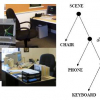Free Online Productivity Tools
i2Speak
i2Symbol
i2OCR
iTex2Img
iWeb2Print
iWeb2Shot
i2Type
iPdf2Split
iPdf2Merge
i2Bopomofo
i2Arabic
i2Style
i2Image
i2PDF
iLatex2Rtf
Sci2ools
ICCV
2007
IEEE
2007
IEEE
Hierarchical Semantics of Objects (hSOs)
A successful representation of objects in the literature is as a collection of patches, or parts, with a certain appearance and position. The relative locations of the different parts of an object are constrained by the geometry of the object. Going beyond the patches on a single object, consider a collection of images of a particular class of scenes containing multiple (recurring) objects. The parts belonging to different objects are not constrained by such a geometry. However the objects, arguably due to their semantic relationships, themselves demonstrate a pattern in their relative locations, which also propagates to their parts. Analyzing the interactions between the parts across the collection of images would reflect these patterns, and the parts can be grouped accordingly. These groupings are typically hierarchical. We introduce hSO: Hierarchical Semantics of Objects, which is learnt from a collection of images of a particular scene and captures this hierarchical grouping. We p...
Related Content
| Added | 12 Oct 2009 |
| Updated | 02 Apr 2010 |
| Type | Conference |
| Year | 2007 |
| Where | ICCV |
| Authors | Devi Parikh, Tsuhan Chen |
Comments (0)






